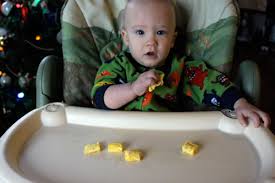Once your baby can sit up and bring her hands or other objects to her mouth, you can give your baby finger foods to help her learn to feed herself. Any finger food you give your baby needs to be soft, easy to swallow, and cut into small pieces. Some examples include:
• Small pieces of banana
• Wafer-type cookies or crackers
• Scrambled eggs
• Well-cooked pasta
• Well-cooked chicken finely chopped
• Well-cooked and cut up yellow squash, peas, and potatoes
At each of your baby’s daily meals, she should be eating about 4 ounces, or the amount in one small jar of strained baby food. Limit giving your baby foods that are made for adults since these foods often contain more salt and other preservatives. Offering your baby fresh food is an excellent choice, but use a blender or food processor, or just mash softer foods with a fork before serving. All fresh foods should be cooked with no added salt or seasoning. Though you can feed your baby raw bananas (mashed), most other fruits and vegetables should be cooked until they are soft. Refrigerate any food you do not use, and look for any signs of spoilage before giving it to your baby. Fresh foods will spoil more quickly than food from a can or jar.
Introduce good eating habits from the start. It is important for your baby to get used to the process of eating—sitting up, taking food from a spoon, resting between bites, and stopping when full. These early experiences will help your child learn good eating habits throughout life.
Encourage family meals from the first feeding. When you can, the whole family should eat together. Research suggests that having dinner together as a family on a regular basis has positive effects on the development of children. Remember to offer a good variety of healthy foods and watch your child for cues that she has had enough to eat. Young children can self-regulate and will stop eating when they are full.
NOTE: Food that requires chewing should not be given to your child at this age. Foods to avoid include: hot dogs (including meat sticks [baby food “hot dogs”]); nuts and seeds; chunks of meat or cheese; whole grapes; popcorn; chunks of peanut butter; raw vegetables; fruit chunks, such as apple chunks; and hard, gooey, or sticky candy.
When your baby starts eating solid foods, it is normal for her stools to become more solid and variable in color, and to have a stronger odor, too. Your baby’s digestive system is still immature and needs time before it can fully process these new foods.

